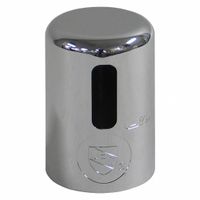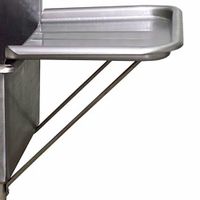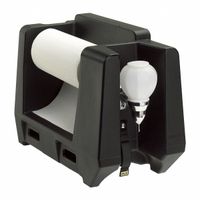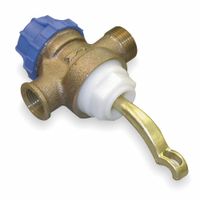Call +(254) 703 030 000 / 751 483 999 / 721 704 777
- Home
- Plumbing
- Sinks Wash Fountains Repair Parts
- Sink Wash Fountain Parts Accessories
Frequently Asked Questions
What are the common types of sink parts and accessories?
Common types of sink parts and accessories include:
1. **Faucets**: These are essential for controlling water flow and temperature. They come in various styles such as single-handle, double-handle, pull-out, and touchless.
2. **Sink Basins**: The main part of the sink where water collects. They vary in size, shape, and material, including stainless steel, porcelain, and composite.
3. **Drains**: These are crucial for water outflow. They often include a strainer or stopper to prevent debris from clogging the pipes.
4. **P-Traps**: A plumbing fixture that traps debris and prevents sewer gases from entering the home. It is typically located under the sink.
5. **Sink Grids**: Protective accessories placed at the bottom of the sink to prevent scratches and damage to the sink surface.
6. **Soap Dispensers**: Built-in or standalone units for dispensing liquid soap, often installed next to the faucet.
7. **Garbage Disposals**: Devices installed under the sink to grind food waste, making it easier to dispose of through the plumbing system.
8. **Air Gaps**: A safety device that prevents backflow of contaminated water into the clean water supply, often used with dishwashers.
9. **Spray Hoses**: Flexible hoses attached to the faucet for extended reach and easier cleaning of dishes and the sink area.
10. **Sink Strainers**: Mesh or perforated devices placed over the drain to catch food particles and debris.
11. **Mounting Clips**: Used to secure the sink to the countertop, especially in undermount sink installations.
12. **Tailpieces**: Pipes that connect the sink drain to the P-trap, ensuring proper water flow.
13. **Sink Mats**: Cushioned mats placed inside the sink to protect dishes and the sink surface from damage.
14. **Cutting Boards**: Custom-fit boards that sit over the sink, providing additional workspace and easy cleanup.
How do I replace a sink faucet?
1. **Gather Tools and Materials**: Adjustable wrench, basin wrench, plumber’s tape, bucket, new faucet, and supply lines if needed.
2. **Turn Off Water Supply**: Locate the shut-off valves under the sink and turn them clockwise to stop the water flow. Open the faucet to release any remaining water.
3. **Disconnect Supply Lines**: Place a bucket under the sink to catch any water. Use an adjustable wrench to disconnect the water supply lines from the faucet.
4. **Remove Old Faucet**: Use a basin wrench to loosen and remove the nuts securing the faucet to the sink. Lift the old faucet out.
5. **Clean the Area**: Clean the sink surface where the old faucet was installed to ensure a proper seal for the new faucet.
6. **Install New Faucet**: Insert the new faucet through the mounting holes. Secure it from underneath using the provided nuts and washers. Tighten with a basin wrench.
7. **Connect Supply Lines**: Attach the water supply lines to the new faucet. Use plumber’s tape on the threads to ensure a tight seal. Tighten with an adjustable wrench.
8. **Check for Leaks**: Turn on the water supply valves. Open the faucet and check for leaks. Tighten connections if necessary.
9. **Test the Faucet**: Ensure both hot and cold water flow properly. Adjust as needed.
10. **Seal the Edges**: Apply a bead of silicone sealant around the base of the faucet to prevent water from seeping underneath.
11. **Clean Up**: Wipe down the area and ensure all tools are put away.
Your new faucet should now be installed and functioning properly.
What is the best material for sink parts?
The best material for sink parts depends on the specific part and its function, but generally, stainless steel, brass, and ceramic are considered top choices due to their durability, resistance to corrosion, and aesthetic appeal.
1. **Stainless Steel**: This is the most popular material for sink basins and some parts like drains and faucets. It is highly durable, resistant to rust and stains, and easy to clean. Stainless steel is also cost-effective and complements modern kitchen and bathroom designs.
2. **Brass**: Often used for faucets and fittings, brass is an alloy of copper and zinc, known for its strength and resistance to corrosion. It has a classic look and can be polished to a high shine, making it a popular choice for both traditional and contemporary designs.
3. **Ceramic**: Commonly used for sink basins, ceramic is valued for its smooth, glossy finish and resistance to scratches and stains. It is easy to clean and maintains its appearance over time, making it ideal for bathroom sinks.
4. **Composite Granite**: This material is a blend of granite stone dust and acrylic resins, used for sink basins. It offers a natural stone appearance, is highly durable, and resistant to scratches and chips.
5. **Copper**: Used for both basins and fixtures, copper is naturally antimicrobial and develops a unique patina over time. It is durable and offers a warm, rustic aesthetic.
6. **Plastic (PVC/ABS)**: Often used for plumbing parts like traps and drains, plastic is lightweight, resistant to corrosion, and cost-effective.
Each material has its advantages, and the choice often depends on the specific requirements of the sink part, budget, and design preferences.
How do I fix a leaking sink?
1. **Identify the Leak**: Determine if the leak is from the faucet, drain, or pipes under the sink.
2. **Turn Off Water Supply**: Locate the shut-off valves under the sink and turn them clockwise to stop water flow.
3. **Faucet Leak**:
- **Tools Needed**: Adjustable wrench, screwdriver, replacement parts (O-rings, washers, or cartridges).
- **Steps**:
1. Remove faucet handle using a screwdriver.
2. Disassemble the faucet to access the O-rings or washers.
3. Replace worn-out parts with new ones.
4. Reassemble the faucet and test for leaks.
4. **Drain Leak**:
- **Tools Needed**: Plumber’s putty, pipe wrench.
- **Steps**:
1. Unscrew the drain flange using a pipe wrench.
2. Clean old putty or sealant from the flange and sink.
3. Apply a new layer of plumber’s putty around the flange.
4. Reinstall the flange and tighten it securely.
5. **Pipe Leak**:
- **Tools Needed**: Pipe wrench, replacement pipes or fittings, Teflon tape.
- **Steps**:
1. Inspect pipes for cracks or loose connections.
2. Tighten loose connections with a pipe wrench.
3. Replace damaged pipes or fittings.
4. Use Teflon tape on threaded connections to ensure a tight seal.
6. **Test for Leaks**: Turn the water supply back on and check for any leaks. Tighten connections if necessary.
7. **Clean Up**: Wipe any excess water and ensure all tools and materials are stored properly.
Where can I buy replacement parts for my wash fountain?
To purchase replacement parts for your wash fountain, you can explore the following options:
1. **Manufacturer's Website**: Visit the official website of the wash fountain's manufacturer. They often have a section for replacement parts or a customer service contact to assist with parts orders.
2. **Authorized Dealers**: Contact authorized dealers or distributors of the wash fountain brand. They typically stock or can order specific parts for you.
3. **Plumbing Supply Stores**: Check with local or online plumbing supply stores. They may carry parts for commercial wash fountains or can special order them.
4. **Online Retailers**: Websites like Amazon, eBay, or specialized plumbing parts retailers may have the parts you need. Ensure compatibility with your specific model.
5. **Industrial Supply Companies**: Companies like Grainger or Ferguson often supply parts for commercial and industrial washroom fixtures, including wash fountains.
6. **Local Plumbers**: Consult with local plumbing professionals who might have access to parts through their suppliers or can recommend where to find them.
7. **Salvage Yards**: For older models, check architectural salvage yards or businesses specializing in reclaimed building materials.
8. **Forums and Online Communities**: Join forums or online communities related to plumbing or commercial washroom fixtures. Members may offer advice on where to find parts or have spare parts available.
9. **Custom Fabrication**: If parts are unavailable, consider custom fabrication through a local machine shop, especially for non-standard or obsolete components.
10. **Contact the Manufacturer**: If all else fails, directly contact the manufacturer for guidance on obtaining parts or recommended alternatives.
Ensure you have the model number and specific part details when searching to facilitate the process.
How do I install a new sink drain?
1. **Gather Tools and Materials**: You will need a new sink drain assembly, plumber’s putty, a wrench, a bucket, and a towel.
2. **Remove Old Drain**: Place a bucket under the sink to catch any water. Use a wrench to loosen the slip nuts on the P-trap and remove it. Unscrew the locknut securing the old drain to the sink and remove the drain flange.
3. **Clean the Sink Area**: Clean the area around the drain hole to ensure a good seal for the new drain.
4. **Prepare the New Drain**: Roll a small amount of plumber’s putty into a rope and apply it around the underside of the new drain flange.
5. **Install the New Drain Flange**: Insert the new drain flange into the sink’s drain hole. Press down firmly to ensure the putty creates a watertight seal.
6. **Secure the Drain Assembly**: From underneath the sink, slide the rubber gasket and friction ring onto the drain tailpiece. Screw the locknut onto the tailpiece and tighten it with a wrench to secure the drain assembly.
7. **Reattach the P-trap**: Align the P-trap with the drain tailpiece and the waste pipe. Tighten the slip nuts by hand, then use a wrench for a snug fit.
8. **Test for Leaks**: Run water into the sink and check for leaks around the drain and P-trap. Tighten connections if necessary.
9. **Clean Up**: Remove any excess plumber’s putty that squeezed out from under the flange.
10. **Final Check**: Ensure all connections are secure and the sink drains properly. Adjust as needed.
What are the signs that I need to replace my sink parts?
Signs that you need to replace your sink parts include:
1. **Leaks**: Persistent leaks from the faucet, pipes, or under the sink indicate worn-out seals or corroded parts that need replacement.
2. **Rust and Corrosion**: Visible rust or corrosion on metal parts like faucets, drains, or pipes suggests deterioration that can lead to leaks or breakage.
3. **Low Water Pressure**: If cleaning the aerator doesn’t restore water pressure, it might be time to replace the faucet or internal components.
4. **Cracks or Chips**: Cracks in the sink basin or chips in the enamel can lead to water damage and should be addressed by replacing the affected parts.
5. **Mold and Mildew**: Persistent mold or mildew growth, especially under the sink, can indicate leaks or moisture issues that require part replacement.
6. **Unusual Noises**: Gurgling or banging noises from the pipes can signal blockages or failing components that need attention.
7. **Stains and Discoloration**: Persistent stains or discoloration on the sink surface or around the faucet base can indicate mineral buildup or corrosion.
8. **Loose Fixtures**: If faucets, handles, or other fixtures are loose and cannot be tightened, replacement may be necessary.
9. **Frequent Repairs**: If you find yourself frequently repairing the same parts, it may be more cost-effective to replace them entirely.
10. **Outdated Design**: An outdated sink or faucet design that no longer meets your needs or aesthetic preferences can be a reason for replacement.
11. **Water Damage**: Signs of water damage in the cabinet or countertop, such as warping or swelling, suggest leaks that may require part replacement.
12. **Foul Odors**: Persistent foul odors from the drain or under the sink can indicate plumbing issues that necessitate replacing parts.



